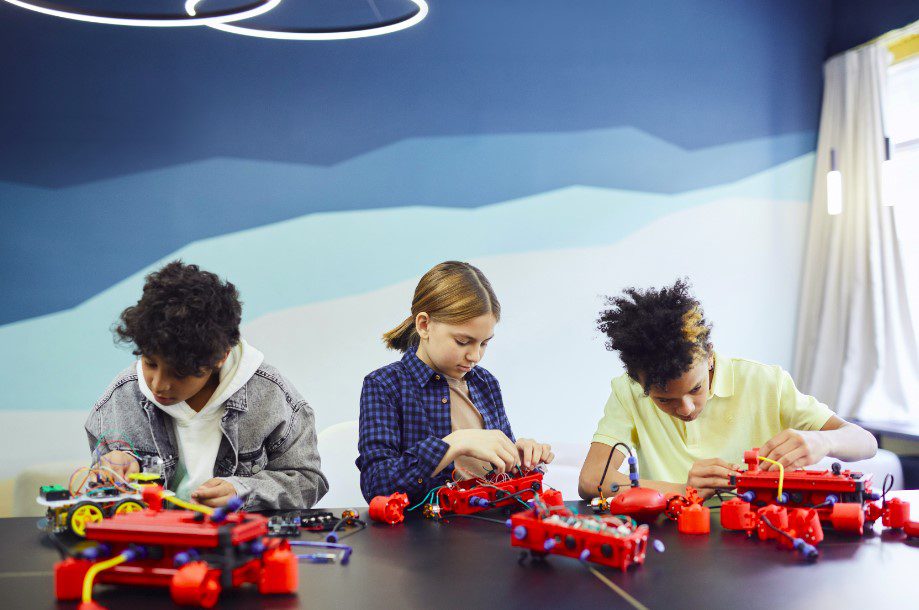In this era of information overload, personalized learning is key to cutting through the noise and capturing the attention of children.
Coupled with rapid technological advancements and evolving educational methodologies, personalized learning can revolutionize traditional teaching approaches and unlock the true potential of every child.
Instruction can be tailored to an individual child’s unique needs, preferences, and pace of learning. The new method of acquiring NEW knowledge and skills revolutionizes traditional classroom standards.
Within the core of personalized learning, are sets of guiding principles that shape its philosophy and methodology. These range from learner centered approaches that place the student at the heart of the educational journey, to flexible pacing and targeted instructions.
Discover how these principles form the backbone of personalized learning and pave the way for a meaningful classroom today.
What is Personalized Learning?

Personalized learning, at its core, is an educational approach that recognizes the unique qualities and needs of each individual learner. It goes beyond the traditional one-size-fits-all model of education.
In addition, it takes Differentiated Learning a step further, by placing the learner at the center of their educational experience. It embraces the logic that students have different learning styles, strengths, interests, and challenges.
In this learning environment, the instructional process is tailored to meet the specific needs of each student. It acknowledges that learners have different paces of learning, varying levels of prior knowledge, and distinct ways of processing information.
The learner is placed in the driver’s seat, and empowered to take an active role in their education. It recognizes that learners have their unique aspirations, goals, and interests, and seeks to align the curriculum and instructional methods with these factors.
In this learning environment, students have more agency and autonomy in their learning journey. They have the opportunity to
- set personal learning goals.
- make choices regarding the pace and path of their learning.
- and engage in activities that are meaningful and relevant to their lives.
This type of learning also leverages data and technology to inform instruction and provide timely feedback. It utilizes assessments and data analysis to gain insights into students’ progress, strengths, and areas for improvement.
This data-driven approach enables educators to tailor instruction, provide targeted interventions, and offer additional support. This ensures that each student receives the necessary resources to succeed.
Key Principles of Personalized Learning

To understand how personalized learning enhances education, it is essential to grasp its key principles. These principles include:
- Learner-Centric Approach: Personalized learning places the learner at the center of the educational experience, recognizing their unique needs and aspirations.
- Flexible Pacing: Students have the freedom to progress at their own pace, ensuring a deeper understanding of concepts before moving forward.
- Targeted Instruction: Instruction is designed to address individual students’ strengths, weaknesses, and learning preferences, promoting greater engagement and mastery.
- Data-Driven Decision Making: Personalized learning leverages data to inform instructional strategies, allowing educators to make informed decisions tailored to each student’s progress.
Benefits of Personalized Learning

Personalized learning offers numerous benefits that foster children’s education and facilitate academic growth.
Let’s explore some of these advantages:
1. Enhanced Student Engagement
Personalized learning actively engages students in their educational journey by catering to their interests and passions. When students find relevance in what they learn, their motivation increases. This is a fertile ground for improved attentiveness, participation, and enjoyment of the learning process.
2. Individualized Instruction
With personalized learning, teachers can create individualized instruction plans based on each student’s specific needs. This targeted approach enables students to receive the support and resources required to grasp concepts thoroughly, ultimately leading to better academic outcomes.
3. Flexibility and Autonomy
By allowing students to progress at their own pace, personalized learning promotes flexibility and autonomy. This flexibility ensures that students have adequate time to fully comprehend complex topics. Then they can have the freedom to explore additional resources and pursue their interests.
4. Promotes Critical Thinking and Problem-Solving Skills
Personalized learning encourages students to think critically and develop problem-solving skills. Through engaging activities and projects aligned with their interests, students are challenged to analyze, synthesize, and apply their knowledge to real-world situations. This fosters a deeper understanding of the subject matter.
Examples of Personalized Learning in Action

To further illustrate the impact of personalized learning on children’s education, let’s explore some real-world examples:
Example 1: Adaptive Learning Platforms
Adaptive learning platforms utilize intelligent algorithms to tailor instruction based on students’ individual progress and learning patterns. These platforms collect data on students’ performance, identify areas of weakness, and deliver targeted content and resources to address specific learning gaps.
For instance, a math program might provide additional practice exercises for a student struggling with fractions. At the same time, it offers more challenging problems to an advanced learner.
Example 2: Project-Based Learning
Project-based learning allows students to apply their knowledge and skills in real-world contexts. Students engage in hands-on projects that require collaboration, critical thinking, and problem-solving.
For example, a science class might task students with designing and constructing a solar-powered device. This makes it possible for them to integrate concepts from physics, engineering, and environmental science ,while fostering creativity and innovation.
Example 3: Individual Learning Plans
Individual Learning Plans (ILPs) are personalized roadmaps that outline specific goals, strategies, and resources for each student. These plans are created collaboratively by teachers, students, and sometimes parents, considering the student’s strengths, interests, and areas for improvement.
An ILP may include customized assignments, alternative assessment methods, and additional support to address individual learning needs.
Example 4: Differentiated Instruction
Differentiated instruction involves tailoring teaching strategies and materials to meet the diverse needs of students in a classroom. Teachers employ various approaches, such as varying the level of difficulty, that provide alternative learning resources.
For instance, in a language arts class, students might have the option to write an essay, create a visual presentation, or engage in a class debate to showcase their comprehension and communication skills.
The Future of Personalized Learning

As technology continues to advance, the future of personalized learning holds even more exciting possibilities. Here are some emerging trends that will shape the landscape of personalized education:
1. Artificial Intelligence and Machine Learning
Artificial Intelligence (AI) and Machine Learning (ML) technologies have the potential to revolutionize personalized learning. With AI-powered systems, educational platforms can analyze vast amounts of student data to provide even more precise and tailored recommendations.
These technologies can adapt in real-time, offering personalized feedback, suggesting relevant resources, and identifying areas where additional support is needed.
2. Virtual and Augmented Reality
Virtual Reality (VR) and Augmented Reality (AR) provide immersive and interactive learning experiences. Students can explore virtual environments, simulate experiments, and engage in virtual field trips, bringing the curriculum to life.
These technologies offer a personalized and engaging way to learn, enabling students to visualize complex concepts and deepen their understanding through hands-on experiences.
3. Adaptive Assessments and Feedback
Adaptive assessments leverage technology to provide personalized evaluations of students’ knowledge and skills. By analyzing individual responses, these assessments adjust the difficulty level and content based on the student’s performance.
Adaptive feedback offers targeted suggestions and resources for improvement, allowing students to focus on specific areas where they need further support.
In Conclusion
Personalized learning has emerged as a powerful educational approach that fosters children’s education by tailoring instruction to their individual needs, interests, and learning styles. When implemented in addition to Differentiated Learning and the Multi-Tiered System of Support (MTSS) model, it can further enhance the educational experience for students.
As technology continues to advance, the possibilities for personalized learning expand even further. With the integration of AI, VR, and adaptive technologies, the future of education holds tremendous potential for unlocking each student’s unique learning journey.
The ultimate goal of personalized learning is to foster deeper engagement, enhance understanding, and promote academic success. By customizing instruction to match the unique needs and interests of each student, personalized learning strives to create a more inclusive, meaningful, and effective educational experience.





Leave a Reply